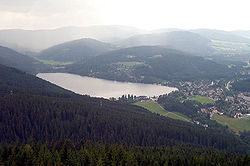Lake Titisee
| Titisee | |
|---|---|

View from the Hochfirst
|
|
| Location | South Black Forest |
| Coordinates | 47°54′N 8°09′E / 47.900°N 8.150°ECoordinates: 47°54′N 8°09′E / 47.900°N 8.150°E |
| Primary inflows | Seebach |
| Primary outflows | Gutach |
| Catchment area | 24.2 km2 (9.3 sq mi) |
| Basin countries | Germany |
| Max. length | 1.87 km (1.16 mi) |
| Max. width | 750 m (2,460 ft) |
| Surface area | 1.07 km2 (0.41 sq mi) |
| Average depth | 20.5 m (67 ft) |
| Max. depth | 39.0 m (128.0 ft) |
| Water volume | 22,500,000 m3 (790,000,000 cu ft) |
| Surface elevation | 845 m (2,772 ft) |
| Settlements | Titisee-Neustadt |
The Titisee is a lake in the southern Black Forest in Baden-Württemberg. It covers an area of 1.3 km2 (320 acres) and is an average of 20 m (66 ft) deep. It owes its formation to the Feldberg glacier, the moraines of which were formed in the epoch and nowadays form the shores of the lake. The lake's outflow, at 840 m (2,760 ft) above sea level, is the River Gutach, which merges with the Haslach stream below Kappel to form the Wutach). The waters of the Titisee thus drain eventually into the Upper Rhine between Tiengen and Waldshut. On the north shore lies the spa town of the same name, today a part of the municipality of Titisee-Neustadt.
There are various theories about the origin of the unusual name Titisee:
In 1840, two sarcophagi made of worked tuff were found below a knoll by the outflow of the Gutach from the Titisee. In 2011, the archaeologist, Andreas Haasis-Berner, published an article stating that they had to date to the period between 700 and 900. Hitherto, it had been thought that the High Black Forest had been unsettled during the first millennium.
The first records of the lake date to 1050 and the abbey of Allerheiligen in Schaffhausen, where the name Titinsee is mentioned. The name Dettesee is also mentioned in a deed from the parish of Saig that dates to 1111. The name of the lake adopted its present from around 1750.
The Titisee takes a long time to freeze over in the winter owing to the winds, which keep the surface of the water moving almost all continuously. For the frozen lake to be opened for use, it must have a solid ice thickness of at least 16 cm (6.3 in) (solid ice or compacted ice has virtually no air pockets). When conditions appear favourable for the opening the lake, daily ice measurements are taken by the Titisee-Neustadt municipal authorities at three or four places. If opening the ice to public use is possible, and those responsible give it their blessing, specific, demarcated areas of the lake are opened, but never the whole lake.
...
Wikipedia
